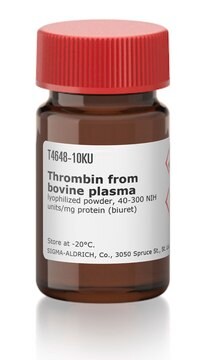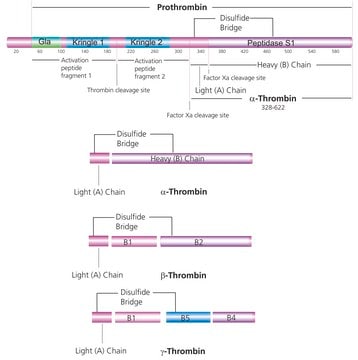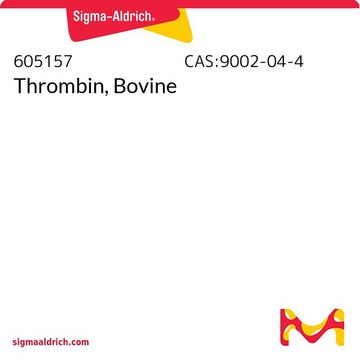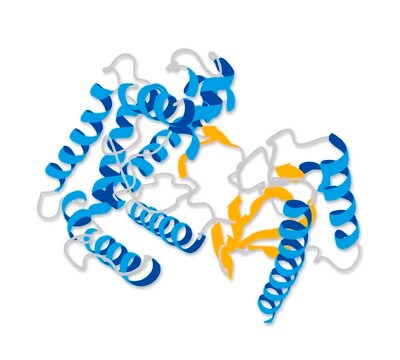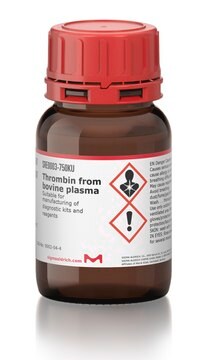T7326
Thrombine from bovine plasma
≥60 NIH units/mg protein (biuret)
Synonyme(s) :
Facteur IIa
Se connecterpour consulter vos tarifs contractuels et ceux de votre entreprise/organisme
About This Item
Numéro CAS:
Numéro MDL:
Code UNSPSC :
12352204
Nomenclature NACRES :
NA.54
Produits recommandés
Forme
lyophilized powder
Activité spécifique
≥60 NIH units/mg protein (biuret)
Composition
Protein, ≥50%
Température de stockage
−20°C
Vous recherchez des produits similaires ? Visite Guide de comparaison des produits
Description générale
Thrombin is the final coagulation protease in regard to hemostasis, promoting both procoagulant and anticoagulant effects. Thrombin comprises of A-chain and B-chain with the catalytic pocket. The C-terminal regions has a fibrinogen recognition site (FRS) and a heparin binding site (HBS). The main function of thrombin is cleavage of fibrinogen to fibrin. It coordinates the coagulation cascade and coordinates with protease-activated receptors (PARs) to regulate physiological functions. High levels of thrombin causes neurotoxicity in dopaminergic neurons and contribute to the progression of parkinsons disease. Altered thrombin levels modulates coagulation pathway in multiple sclerosis. Patients with coronary artery disease (CAD) show elevated levels of thrombin.
Application
Thrombin from bovine plasma may be used:
as revitalization model to mimic blood fabrication in root canal
- for the generation of fibrin from fibrinogen embedded in microbubbles
- for the cleavage of hydrogenase maturation protein (HypF-N) from the nickel resin
as revitalization model to mimic blood fabrication in root canal
Thrombin is used for site specific cleavage of recombinant fusion proteins containing an accessible thrombin recognition site for removal of affinity tags. Thrombin has been used in a study to evaluate coagulation abnormalities in acute liver failure.
Actions biochimiques/physiologiques
Sérine protéase qui clive sélectivement les liaisons Arg-Gly du fibrinogène pour former la fibrine et les fibrinopeptides A et B.
Définition de l'unité
Activity is expressed in NIH units obtained by direct comparison to a NIH thrombin reference standard.
Forme physique
Lyophilized powder containing sodium chloride and Tris-HCl, pH 7.0
Notes préparatoires
Traditional thrombin products are activated with bovine brain thromboplastin, whereas T7326 is activated with bovine lung thromboplastin and does not contain any bovine brain products in its preparation.
Remarque sur l'analyse
La procédure d′essai selon NIH utilise 0,2 ml de plasma dilué (1:1 dans une solution saline) comme substrat et 0,1 ml d′échantillon de thrombine (stabilisé dans une solution tamponnée contenant 1 % d′albumine) et est une modification de la méthode de Biggs. Seuls les temps de coagulation dans la plage de 15 à 25 secondes sont utilisés pour déterminer les concentrations en thrombine.
L′activité est exprimée en unités de NIH et obtenue par comparaison directe à une norme de référence de thrombine NIH, Lot K.
Autres remarques
View more information on thrombin at www.sigma-aldrich.com/enzymeexplorer.
Code de la classe de stockage
11 - Combustible Solids
Classe de danger pour l'eau (WGK)
WGK 3
Point d'éclair (°F)
Not applicable
Point d'éclair (°C)
Not applicable
Équipement de protection individuelle
Eyeshields, Gloves, type N95 (US)
Faites votre choix parmi les versions les plus récentes :
Déjà en possession de ce produit ?
Retrouvez la documentation relative aux produits que vous avez récemment achetés dans la Bibliothèque de documents.
Les clients ont également consulté
Increased plasma thrombin potential is associated with stable coronary artery disease: An angiographically-controlled study
Tosi F, et al.
Thrombosis Research, 155, 16-22 (2017)
Banwari Agarwal et al.
Journal of hepatology, 57(4), 780-786 (2012-06-28)
In acute liver failure (ALF), prothrombin time (PT) and its derivative prothrombin time ratio (PTR) are elevated, and are considered predictors of increased bleeding risk. We aimed at determining whether increased PT/PTR reflects the haemostatic potential and bleeding risk in
Backbone NMR assignments of HypF-N under conditions generating toxic and non-toxic oligomers
Patel JR, et al.
Biomolecular NMR Assignments, 1-5 (2018)
A training model for revitalization procedures
Widbiller M, et al.
International Endodontic Journal, 51, e301-e308 (2018)
Fibrin-Targeted Polymerized Shell Microbubbles as Potential Theranostic Agents for Surgical Adhesions
Gormley CA, et al.
Langmuir (2019)
Notre équipe de scientifiques dispose d'une expérience dans tous les secteurs de la recherche, notamment en sciences de la vie, science des matériaux, synthèse chimique, chromatographie, analyse et dans de nombreux autres domaines..
Contacter notre Service technique